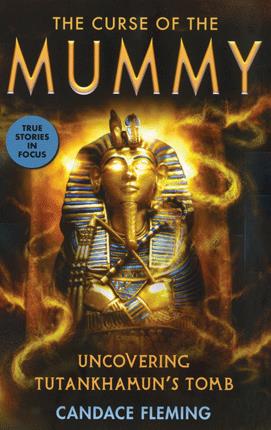| Curse of the mummy : uncovering Tutankhamun's tomb Author: Fleming, Candace | ||
| Price: $23.28 | ||
Summary:
During the reign of the New Kingdom of Egypt, the boy pharaoh Tutankhamun ruled and died tragically young. In order to send him on his way into the afterlife, his tomb was filled with every treasure he would need after death. And then, it was lost to time, buried in the sands of the Valley of the Kings. His tomb was also said to be cursed. Centuries later, as Egypt-mania gripped Europe, two Brits -- a rich earl with a habit for gambling and a disreputable, determined archeologist -- worked for years to rediscover and open Tutankhamun's tomb. But once it was uncovered, would ancient powers take their revenge for disturbing and even looting the pharaoh's resting place? What else could explain the mysterious illnesses, accidents, and deaths that began once it was found?![]() Download a Teacher's Guide
Download a Teacher's Guide
Video Preview:
| Accelerated Reader Information: Interest Level: MG+ Reading Level: 6.80 Points: 6.0 Quiz: 513190 |
Reviews:
Kirkus Reviews (-) (07/15/21)
School Library Journal (08/01/21)
Booklist (+) (09/15/21)
Full Text Reviews:
School Library Journal - 08/01/2021 Gr 6 Up—Fleming has done it again and created another engaging nonfiction history for middle and high school students with this deep dive into the excavation of the tomb of Tutankhamun. Grave robbers had been looting Egyptian tombs for thousands of years and British and French politics dominated Egypt at the turn of the century with little oversight of the ransacking. Despite this disarray, Tutankhamun's tomb remained hidden and largely untouched until 1922, when it was unearthed by Howard Carter, an archaeologist seen as a disreputable outsider in Europe's snobbish Egyptology scene. He was working for the hapless Lord Carnarvon, a British noble who fancied excavation as a hobby. Together they would toil away for years, excavating the hundreds of treasures while battling local and international politics over ownership rights. With swiftly moving text, Fleming covers many aspects of the story, including the gruesome mummification process, ancient Egyptian history, as well as the discriminatory policies of colonial rule. In addition to a spirited narrative of the facts, Fleming adds to the mystery and intrigue by opening each chapter with dark, cryptic anecdotes of some of the strange, unexplained deaths that were often attributed to the belief that the tomb was cursed. A final chapter discusses the possibilities and probabilities of such a curse. VERDICT This engrossing read is a sure bet that will please all history lovers. Recommended for all libraries serving teens.—Karen Bilton, Franklin Township P.L., NJ - Copyright 2021 Publishers Weekly, Library Journal and/or School Library Journal used with permission.
Booklist - 09/15/2021 *Starred Review* In Fleming’s capable hands, the story of the boy king and Howard Carter’s discovery of his tomb brims with enthusiasm, wonder, and mystique. While she doesn’t sensationalize events, she does capitalize on the natural allure of thieves, treasure, and ancient curses, weaving all these through her account and thus ensuring her readers stay with her from start to finish. Easy-to-read but substantive, this history introduces readers to certain ancient Egyptian beliefs and practices, as well as important political and social circumstances in Carter’s Egypt during the 1920s and ’30s. Fleming expertly sets the scene and imbues both Carter and his benefactor, Lord Carnarvon, with personality as she unfolds events chronologically, highlighting Carter’s meticulous excavation methods. Care is taken to discuss the negative impact of colonialism at work in Egypt during this time, and Carter’s own flaws are likewise pointed out, most effectively in the chapter describing the irreverent handling of Tutankhamun’s mummy. Fleming also tantalizingly traces the misfortunes of those connected with the tomb, showing easily how these were interpreted as an ancient curse, before thoroughly debunking this idea. Throughout the book, black-and-white period photographs show the tomb’s treasures and key players at work (including captions that acknowledge unnamed Egyptian workers). Back matter outlines Tutankhamun’s position in ancient Egyptian history and features a bibliography and source notes. A compelling peek at one of the world’s greatest discoveries. - Copyright 2021 Booklist.





